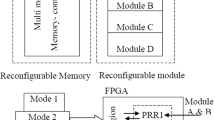Abstract
For field programmable gate arrays (FPGAs) to retain their semiconductor market and to be competitive as a choice for portable applications, the FPGA industry must adopt new techniques for dynamic and static power reduction. In this paper, a new scheme called ‘self clock-gating’ is introduced to reduce the dynamic power of basic logic elements. Circuits are designed using 16 nm Berkeley’s Predictive technology model and tanner EDA tool is used for simulation. When we consider the average power, proposed architecture consumes 14% lesser than standard architecture. However, proposed architecture consumes only 6% of static power as that of standard architecture. If we consider the energy (power delay product), with the leakage reduction technique, the power delay product is 0.164 femto joules for the proposed architecture but in standard architecture, it is 0.200 femto joules.





Similar content being viewed by others
References
Kuon, I., Tessier, R., & Rose, J. (2008). FPGA architecture: Survey and Challenges. Foundations and Trends in Electronic Design Automation, 2(2), 135–253.
Ahmed, E., & Rose, J. (2002). The effect of LUT and cluster size on deep-submicron FPGA performance and density. In ACM/SIGDA international symposium on field programmable gate arrays (pp. 85–94). Monterey, CA.
Li, F., Chen, D., He, L., & Cong, J. (2003). Architecture evaluation for power efficient FPGAs. In ACM/SIGDA international symposium on field programmable gate arrays (pp. 175–184). Monterey, CA.
Farooq, U., et al. (2012). Tree-based heterogeneous FPGA architectures, chapter 2. New York: Springer.
Baharvand, F., & Fakhraie, S. M. (1997). Design of an optimized architecture for the logic blocks of FPGA ICs. In Third annual international conference Computer Society of Iran (Tehran, Iran) (pp. 206–214). December 23–25, 1997.
Rivoallon, F. (2011). Reducing switching power with intelligent clock gating. Xilinx white paper, WP370 (v1.3). March 1, 2011.
Huda, S., Mallick, M., & Anderson, J. H. (2009). Clock gating architectures for FPGA power reduction. In International conference on field programmable logic and applications (pp 12–118).
Chen, D., Cong, J., & Fan, Y. (2003). Low-power high-level synthesis for FPGA architectures. In Proceedings of ISLPED’03.
Lamoureux, J., & Luk, W. (2008). An overview of low-power techniques for field-programmable gate arrays. In NASA/ESA conference on adaptive hardware and systems (pp. 338–345).
Mortdal, S., & Memik, S. O. (2006). Power optimization techniques for SRAM based FPGAs. In Proceedings of international conference on field programmable logic and applications (pp. 1–2).
Zhao, W., & Cao, Y. (2006). New generation of predictive technology model for sub-45 nm early design exploration. IEEE Transactions on Electron Devices, 53(11), 2816–2823.
Berkeley Predictive Technology Model, University of California, Berkeley, 2004. http://www.device.eecs.berkeley.edu/~ptm/. Accessed Mar 2013.
Acknowledgements
Authors acknowledge the immense help received from the scholars whose articles are cited and included in references of this manuscript. The authors are also grateful to authors/editors/publishers of all those articles, journals and books from where the literature for this article has been reviewed and discussed.
Author information
Authors and Affiliations
Corresponding author
Rights and permissions
About this article
Cite this article
Udaiyakumar, R., Joseph, S., Sundararajan, T.V.P. et al. Self Clock-Gating Scheme for Low Power Basic Logic Element Architecture. Wireless Pers Commun 102, 3477–3488 (2018). https://doi.org/10.1007/s11277-018-5385-2
Published:
Issue Date:
DOI: https://doi.org/10.1007/s11277-018-5385-2




